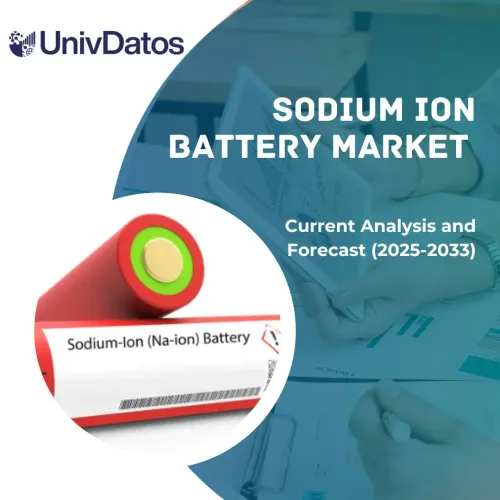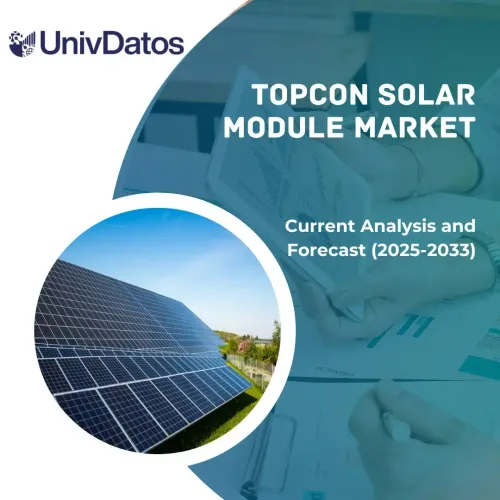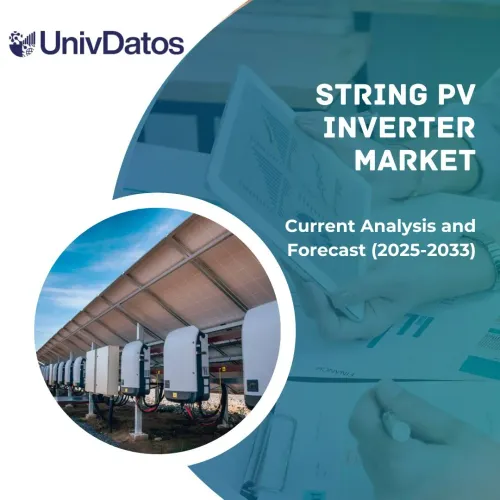- Home
- About Us
- Industry
- Services
- Reading
- Contact Us
Solar PV Junction Box Market: Current Analysis and Forecast (2021-2027)
Emphasis on Type (Potting PV Junction Box, Non-potting PV Junction Box); Application (Residential, Commercial & Industrial, Utilities); Region/Country
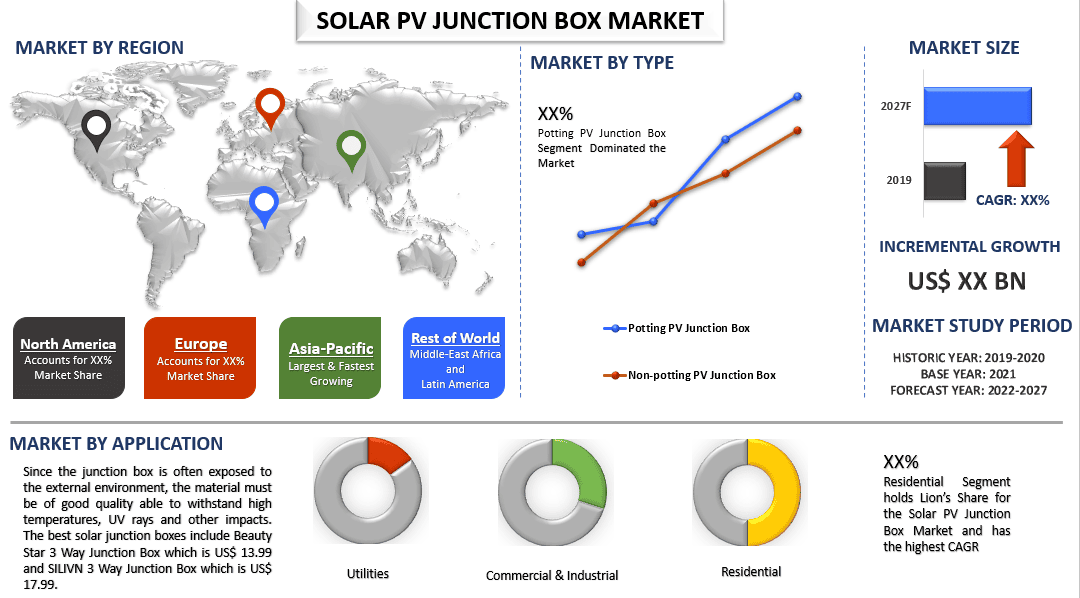
Global Solar PV Junction Box Market was valued at US$ 1.3 Billion in 2020 and is anticipated to reach US$ 2 Billion by 2027 displaying an elevated CAGR of 6.8% over the forecast period (2021-2027). The photovoltaic (PV) junction box is an important part of the solar panels. The junction box is the enclosure on the module where the PV strings are electrically connected. The PV junction box is typically attached at the back of the solar panel with a silicon adhesive. This wires the connectors (usually 4) together and is the output interface of the solar panels. Good quality junction boxes keep corrosion at minimal in the terminals by excluding water from coming in. The IP rating of the junction boxes matters a lot. A junction box with IP 67 rating is completely watertight. Photovoltaic junction boxes have diodes, which keep the power flow in one direction and prevent power from feeding back into the panels when there is no sunshine. The quality of PV junction box is certified (e.g., Via TUV) and regulated the heat which offers long term safety.
Key factors influencing the solar PV junction box market growth include the growing demand of electricity over the years due to industrialization in developing countries and increase per person use of electricity all over the globe. Other factors such as growing economy, increasing population and rapid urbanization are also creating a surge in the electricity demand. According to IEA’s semiannual electricity report, the global electricity demand is expected to grow 5% in 2020 and 4% in 2021, driven by the global economic recovery. The joint move towards renewable energy sources around the world is promoting the use of solar panels and other renewable sources of energy to acknowledge this increasing energy crisis. Installation of solar panels is increasing at a tremendous rate leading to the growth in solar PV junction box market. The number of solar panel installations in the United States grew from 13,484 installations in 2019 to 19,221 installations in 2020.
Different Types of Solar PV Junctions and Their Features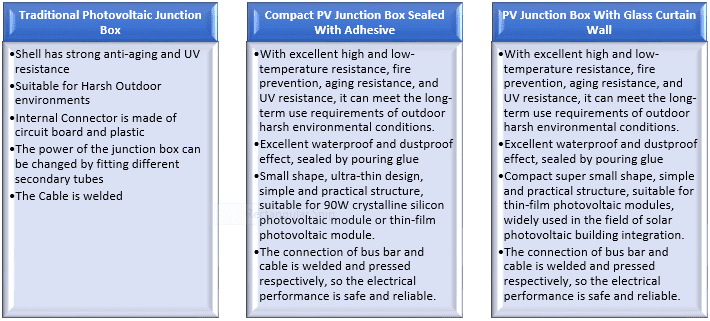
GEESYS Technologies, Targray, Elcom International, LEONI AG, Zhejiang Zhonghuan Sunter PV Technology Co. Ltd, Hosiden Corporation, Jiangsu Tongling Electric Co., Ltd., Stäubli International AG, VRM Energy Consultancy Services Pvt Ltd., and TE Connectivity are some of the prominent players operating in the Solar PV Junction Box market. Several M&As along with partnerships have been undertaken by these players to facilitate customers with hi-tech and innovative products/technologies.
Insights Presented in the Report
“Amongst Type, Potting PV Junction Box segment holds the major share”
Based on type, the Solar PV Junction Box market is segmented into Potting PV Junction Box and Non-potting PV Junction Box. Amongst type, the potting PV junction box segment of the market was valued at US$ XX million in 2020 and is likely to reach US$ XX million by 2027 growing at a CAGR of XX% from 2021-2027. The potting PV junction method solders the foils coming out of the solar panel to the diode in the junction box. The junction box must then be potted or filled with a type of sticky material which allows thermal heat transfer, keeps the solder joint in place and prevents it from failing.
“Amongst Application, Residential Segment holds the major share”
Based on Application, the Solar PV Junction Box market is segmented into Residential, Commercial & Industrial, and Utilities. Amongst application, Residential segment accounted for a market valuation of US$ XX million in 2020 and is expected to reach US$ XX million by the year 2027, at a CAGR of XX% over the analyzed period. Solar panels are more commonly used in homes as compared to commercial or utilities settings, and thus the higher use of Solar PV junction boxes in residential homes. While choosing a PV junction box the quality of the material being used is the key factor.
“Asia Pacific represents one of the largest markets of Solar PV Junction Box market”
For a better understanding of the market dynamics of the Solar PV Junction Box market, a detailed analysis was conducted for different regions across the globe including North America (the U.S, Canada, and the Rest of North America), Europe (Germany, France, Italy, United Kingdom, Spain, and Rest of Europe), Asia-Pacific (China, Japan, India, Australia, and Rest of APAC) and Rest of the World. Asia Pacific dominated the market and grabbed around XX% market share owing to increased industrialization in the region.
Reasons to buy this report:
- The study includes market sizing and forecasting analysis validated by authenticated key industry experts
- The report presents a quick review of overall industry performance at one glance
- The report covers an in-depth analysis of prominent industry peers with a primary focus on key business financials, product portfolio, expansion strategies, and recent developments
- Detailed examination of drivers, restraints, key trends, and opportunities prevailing in the industry
- The study comprehensively covers the market across different segments
- Deep dive regional level analysis of the industry
Customization Options:
Solar PV Junction Box market can further be customized as per the requirement or any other market segment. Besides this, UMI understands that you may have your own business needs, hence feel free to connect with us to get a report that completely suits your requirements.
Table of Content
Analyzing the historical market, estimation of the current market, and forecasting the future market of the Solar PV Junction Box market were the three major steps undertaken to create and analyze the adoption of Solar PV Junction Box in major regions globally. Exhaustive secondary research was conducted to collect the historical market numbers and estimate the current market size. Secondly, to validate these insights, numerous findings and assumptions were taken into consideration. Moreover, exhaustive primary interviews were also conducted, with industry experts across the value chain of the Solar PV Junction Box market. Post assumption and validation of market numbers through primary interviews, we employed a top-down/bottom-up approach to forecasting the complete market size. Thereafter, market breakdown and data triangulation methods were adopted to estimate and analyze the market size of segments and sub-segments the industry pertains to. Detailed methodology is explained below:
Analysis of Historical Market Size
Step 1: In-Depth Study of Secondary Sources:
Detail secondary study was conducted to obtain the historical market size of the Solar PV Junction Box through company internal sources such as annual report & financial statements, performance presentations, press releases, etc., and external sources including journals, news & articles, government publications, competitor publications, sector reports, third-party database, and other credible publications.
Step 2: Market Segmentation:
After obtaining the historical market size of the Solar PV Junction Box market, we conducted a detailed secondary analysis to gather historical market insights and share for different segments & sub-segments for major regions. Major segments included in the report as Type and Application. Further country-level analyses were conducted to evaluate the overall adoption of Solar PV Junction Box in that region.
Step 3: Factor Analysis:
After acquiring the historical market size of different segments and sub-segments, we conducted a detailed factor analysis to estimate the current market size of Solar PV Junction Box. Further, we conducted factor analysis using dependent and independent variables such as increasing urbanization and industrialization. A thorough analysis was conducted for demand and supply-side scenarios considering top partnerships, merger and acquisition, business expansion, and product launches in the Solar PV Junction Box sector across the globe.
Current Market Size Estimate & Forecast
Current Market Sizing: Based on actionable insights from the above 3 steps, we arrived at the current market size, key players in the Solar PV Junction Box market, and market shares of the segments. All the required percentage shares split, and market breakdowns were determined using the above-mentioned secondary approach and were verified through primary interviews.
Estimation & Forecasting: For market estimation and forecast, weights were assigned to different factors including drivers & trends, restraints, and opportunities available for the stakeholders. After analyzing these factors, relevant forecasting techniques i.e., top-down/bottom-up approach was applied to arrive at the market forecast about 2027 for different segments and subsegments across the major markets globally. The research methodology adopted to estimate the market size encompasses:
- The industry’s market size, in terms of value (US$) and the adoption rate of Solar PV Junction Box across the major markets domestically
- All percentage shares, splits, and breakdowns of market segments and sub-segments
- Key players in the Solar PV Junction Box market in terms of products offered. Also, the growth strategies adopted by these players to compete in the fast-growing market
Market Size and Share Validation
Primary Research: In-depth interviews were conducted with the Key Opinion Leaders (KOLs) including Top Level Executives (CXO/VPs, Sales Head, Marketing Head, Operational Head, and Regional Head, Country Head, etc.) across major regions. Primary research findings were then summarized, and statistical analysis was performed to prove the stated hypothesis. Inputs from primary research were consolidated with secondary findings, hence turning information into actionable insights.
Split of Primary Participants in Different Regions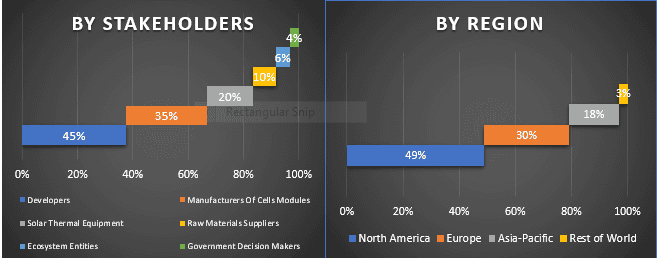
Market Engineering
Data triangulation technique was employed to complete the overall market estimation and to arrive at precise statistical numbers of each segment and sub-segment of the Solar PV Junction Box market. Data was split into several segments & sub-segments post studying various parameters and trends in the areas of type and their type of the Solar PV Junction Box market.
The main objective of the Solar PV Junction Box Market Study
The current & future market trends of Solar PV Junction Box were pinpointed in the study. Investors can gain strategic insights to base their discretion for investments from the qualitative and quantitative analysis performed in the study. Current and future market trends were determined the overall attractiveness of the market at a regional level, providing a platform for the industrial participant to exploit the untapped market to benefit as a first-mover advantage. Other quantitative goals of the studies include:
- Analyze the current and forecast market size of Solar PV Junction Box in terms of value (US$). Also, analyze the current and forecast market size of different segments and sub-segments
- Segments in the study include areas of type and their subtypes
- Define and analysis of the regulatory framework for the Solar PV Junction Box industry
- Analyze the value chain involved with the presence of various intermediaries, along with analyzing customer and competitor behaviors of the industry
- Analyze the current and forecast market size of the Solar PV Junction Box market for the major region
- Major regions studied in the report include North America (the U.S, Canada, and Rest of North America), Europe (Germany, United Kingdom, France, Spain, Italy, and Rest of Europe), Asia-Pacific (China, Japan, India, Australia, and Others), and the Rest of the World
- Company profiles of the Solar PV Junction Box market and the growth strategies adopted by the market players to sustain in the fast-growing market
Deep dive regional level analysis of the industry
Related Reports
Customers who bought this item also bought


